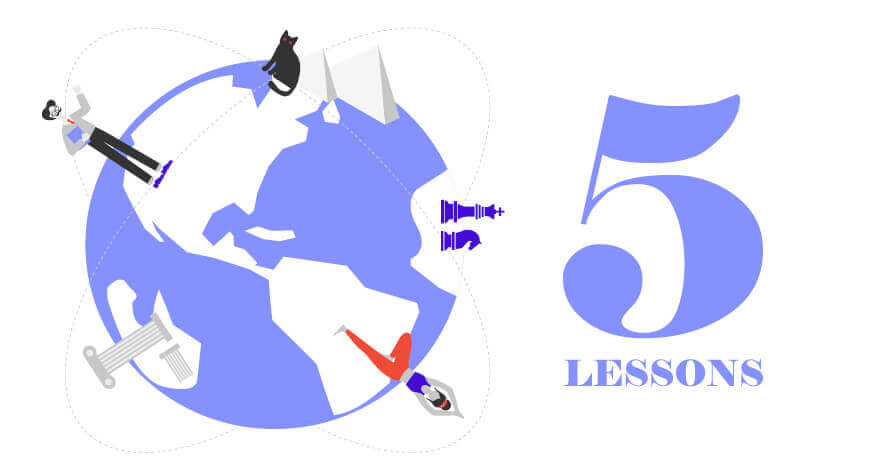
Educational practices are as old as time, but what can we learn about transforming today’s training by looking back to the ancient ways? Here are 5 of the best tips and tricks from some long-forgotten educational systems, found everywhere from China to Rome.
- Getting Hands-on with the Romans
Professor Eleanor Dickey published her book, Learning Latin the Ancient Way, where she discusses her experiences running the modern-day Ancient Schoolroom event, where students can learn as the Romans did. This includes one-on-one teaching between a student and the instructor, and the use of hands-on learning tools in areas like Mathematics, for example, an abacus or counting beans instead of writing numbers on paper.
Professor Dickey finds that “children really engage with the ancient teaching methods, especially when it comes to mathematics. We’ve found that children who aren’t naturally gifted at mathematics actually enjoy using the abacus and counting boards, and this helps to stimulate their interest and learning of the subject.”
We’re no strangers to this process at Cloudshare. Our virtual labs allow for hands-on practice and trial and error with today’s software solutions, perfect for those that struggle with theoretical learning.
- Keeping it Consistent with the Egyptians
If you were working your way through school in Ancient Egypt, you’d be either a scribe-in-training or a priest-in-training. Vocational or hands-on skills were taught outside of formal training academies, usually as apprenticeships or on the job training. The focus of the day was on conformity and discipline. In fact, any deviation from a strict curriculum was against the law. As such, the most common way to learn under the Egyptian school system was by memorization and drill.
While we’re more friendly towards freedom of education than our ancient Egyptian friends, we do see the value in a consistent user experience. That’s why Cloudshare virtual labs can be saved as blueprints and replicated to as many users as necessary so that every trainee starts with an identical environment, no matter the networking complexity.
How to Deliver the Best Remote Virtual Training

-
- Leveling the Playing Field in Ancient China
China has one of the oldest known education systems, dating as far back as the 16th Century BC. But unlike the skills-based learning of some of the other early learning models, Confucianism is considered to be the biggest influence on the education system in China, even today. Within this model of study, moral character, discipline, and harmonious human contact are more important than practical skills. Talk about being ahead of its time, rather than being saved for the children of nobility, education was known as “the greatest equalizing force in ancient China. It enabled those born to the humblest backgrounds to rise to the highest levels in society—to become government officials, strategic advisers, physicians, artists, and poets.”
Education for the masses? We couldn’t agree more. Cloudshare labs are available to anyone, anywhere, with nothing but a laptop and a web browser. You might say, the greatest equalizing force of… remote training solutions. Too much?
- Learning from the Greek Masters
One thing that all education systems need is an instructor, and no-one knows that better than the Ancient Greeks. But hey, who taught the first teacher? In Ancient Greece, even the masters all had their tutors, and Aristotle would be nothing without Plato, who would have been lost without Socrates, who might not be half as well-known without Prodikos… and so on. Whether you believe the Greek myths and think the Centaur Chiron is responsible for the source of all of this wisdom, or you prefer to thank a long-forgotten chain of philosophers – one thing is clear: You can’t get anywhere without a great teacher.
That’s exactly why we set up our virtual environments to be the perfect mix of instructor-led and self-paced learning. Kick-off your training with an integrated instructor-led session via Zoom or any other video conferencing software, and then empower your users to learn at their own pace, with ‘over-the-shoulder’ mode meaning that help is never far off.
- Bringing it all Together in Ancient India
The Vedic system, in 1500BC-600BC India, gives us a lot to learn from, laying out three stages of learning. Studies were given orally in Sanskrit, and the three steps were thought to give students the best chance of what we would today call knowledge retention. These were:
- Shravana: This was the process of listening to the teachers, known as Shrutis, as they shared wisdom and imparted their knowledge.
- Manana: Translated as reflection, this is where students take this knowledge and think about it themselves, taking the time to ask questions and consider what they’ve learned.
- Nididhyāsana: The third element is application, taking this information and applying it practically, learning by doing, and seeing how it works in a tangible way.
These steps could have been written in 2020! With Cloudshare’s virtual hands-on experiences, an instructor can set up all of the right resources for their students to learn the information they need, knocking stage one out of the park. In the second stage, the platform allows each student to ask questions via chat to get the insight that they need, and then lastly, to trial the software with a hands-on experience that lets them discover how the technology works in a real-world setting.
Leveraging Ancient Methods for Today’s Software Training
As it turns out, the ancient educators already knew engagement was key to any effective learning. At CloudShare, we’re merely following suit, adopting the training methods humanity has already proven to be successful.
Want to see how it works for yourself? Let’s schedule a demo.
Convert text to unicode characters and create fancy styles in your documents.



